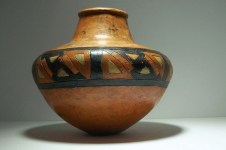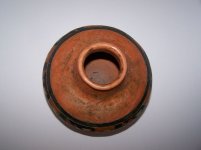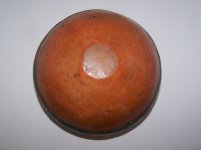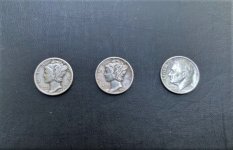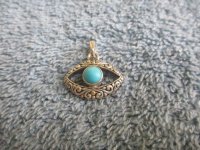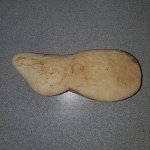Hi All,
Sharing a very interesting painted and incised pottery jar, Great Plains culture, end of 19th century under this heading which came in a purchase from a large thrift shop in Ohio a few years back.
The many details of its complex geometric patterning and the symbolism it incorporates match what can be prominently found in the art of the Sioux, Apache, and Kiowa of that period. By the interpretations of the detailing, the jar offers viewers the forever statement of Native beliefs and the complexities of life on the Plains back in time.
The body of the jar is rough unrefined, only partly burnished with some fossil impressions left in the clay. The overall character of the jar's shape with its sloping neck, wide girth, and conical base resemble the shape of some period Apache jars, including the unusual character of the rolled lip. And continuing with the Apache connections, oxblood red which is commonly found in the 19th-century art of the Chicahua, was used to denote in its special context spilled blood on the smaller flesh-toned warrior stripes found in each rectangle
The thread below is a link to the North American Indian Artifacts section of this site. The research project developed in the thread takes a deep dive into this complex world of cultural symbolism in Native art of the region. Please refer to the thread for explanations and supporting evidence in any of the segments including on its shape, color choices, type of paint, marks, geometric shape symbolism and so forth.
Old Incised Great Plains Painted Pottery Jar | TreasureNet 🧭 The Original Treasure Hunting Website
Importantly, the patterning consists of six well-balanced and equally designed rectangular sections which together form a circle around the jar. A circle is the symbol of unity as with an alliance among tribes or warrior societies. The rectangle is a symbol of territory or space with a culturally significant sacred center worthy of protection given the symbolism in the illustration. Color choices can have different interpretations, however, In this context, yellow at the center is the symbol of the creator. The twin peaks which meet in the center, one above and one below in black and yellow might signify a culturally important and sacred mountain top with black then symbolizing a source of power for the culture derived from there.
The patterning is reversible whether viewing the jar in the upright position or upside down to empty the contents, the view is the same.
Finally, there are two very important sets of impressions left in the clay by the artist, on the bottom interior, page 3 in the thread. the minimalist bird face, and the other a circle with a horizontal line below. Separately, these can be connected to the art known to be a part of Kiowa and Plains Apache culture of the late 19th century. Rather than a product of random circumstances, such as by the pit firing method to bake the jar, both were put there intentionally by the artist while the clay was still wet. And, on close inspection, the clay was moved around and displaced before drying to produce these impressions
Posting this piece on a public forum, I believe was the right choice for its content, and I am grateful for the opportunity this site has given me to share this with other members who might venture into thrift shops for their historic mystery pieces.
thank you for looking
Kind regards,
Kevin
Sharing a very interesting painted and incised pottery jar, Great Plains culture, end of 19th century under this heading which came in a purchase from a large thrift shop in Ohio a few years back.
The many details of its complex geometric patterning and the symbolism it incorporates match what can be prominently found in the art of the Sioux, Apache, and Kiowa of that period. By the interpretations of the detailing, the jar offers viewers the forever statement of Native beliefs and the complexities of life on the Plains back in time.
The body of the jar is rough unrefined, only partly burnished with some fossil impressions left in the clay. The overall character of the jar's shape with its sloping neck, wide girth, and conical base resemble the shape of some period Apache jars, including the unusual character of the rolled lip. And continuing with the Apache connections, oxblood red which is commonly found in the 19th-century art of the Chicahua, was used to denote in its special context spilled blood on the smaller flesh-toned warrior stripes found in each rectangle
The thread below is a link to the North American Indian Artifacts section of this site. The research project developed in the thread takes a deep dive into this complex world of cultural symbolism in Native art of the region. Please refer to the thread for explanations and supporting evidence in any of the segments including on its shape, color choices, type of paint, marks, geometric shape symbolism and so forth.
Old Incised Great Plains Painted Pottery Jar | TreasureNet 🧭 The Original Treasure Hunting Website
Importantly, the patterning consists of six well-balanced and equally designed rectangular sections which together form a circle around the jar. A circle is the symbol of unity as with an alliance among tribes or warrior societies. The rectangle is a symbol of territory or space with a culturally significant sacred center worthy of protection given the symbolism in the illustration. Color choices can have different interpretations, however, In this context, yellow at the center is the symbol of the creator. The twin peaks which meet in the center, one above and one below in black and yellow might signify a culturally important and sacred mountain top with black then symbolizing a source of power for the culture derived from there.
The patterning is reversible whether viewing the jar in the upright position or upside down to empty the contents, the view is the same.
Finally, there are two very important sets of impressions left in the clay by the artist, on the bottom interior, page 3 in the thread. the minimalist bird face, and the other a circle with a horizontal line below. Separately, these can be connected to the art known to be a part of Kiowa and Plains Apache culture of the late 19th century. Rather than a product of random circumstances, such as by the pit firing method to bake the jar, both were put there intentionally by the artist while the clay was still wet. And, on close inspection, the clay was moved around and displaced before drying to produce these impressions
Posting this piece on a public forum, I believe was the right choice for its content, and I am grateful for the opportunity this site has given me to share this with other members who might venture into thrift shops for their historic mystery pieces.
thank you for looking
Kind regards,
Kevin
Attachments
Last edited:



